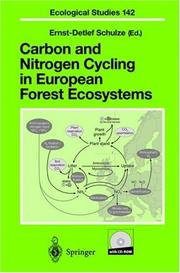| Listing 1 - 4 of 4 |
Sort by
|
Book
Year: 1985 Publisher: Washington, D.C. Springfield, Va. U.S. Dept. of Energy, Office of Energy Research, Office of Basic Energy Sciences, Carbon Dioxide Research Division ; Available from National Technical Information Service, U.S. Dept. of Commerce
Abstract | Keywords | Export | Availability | Bookmark
 Loading...
Loading...Choose an application
- Reference Manager
- EndNote
- RefWorks (Direct export to RefWorks)
Atmospheric carbon dioxide --- Carbon cycle (Biogeochemistry)

ISBN: 3540670254 9783540672395 3540672397 9783540670254 Year: 2000 Publisher: Berlin: Springer,
Abstract | Keywords | Export | Availability | Bookmark
 Loading...
Loading...Choose an application
- Reference Manager
- EndNote
- RefWorks (Direct export to RefWorks)
Book
ISBN: 0262285614 1435665406 9780262285612 9781435665408 0262220830 9780262220835 026226501X Year: 2008 Publisher: Cambridge, MA : MIT Press,
Abstract | Keywords | Export | Availability | Bookmark
 Loading...
Loading...Choose an application
- Reference Manager
- EndNote
- RefWorks (Direct export to RefWorks)
An introduction to the global carbon cycle and the human-caused disturbances to it that are at the heart of global warming and climate change.The most colossal environmental disturbance in human history is under way. Ever-rising levels of the potent greenhouse gas carbon dioxide (CO2) are altering the cycles of matter and life and interfering with the Earth's natural cooling process. Melting Arctic ice and mountain glaciers are just the first relatively mild symptoms of what will result from this disruption of the planetary energy balance. In CO2 Rising, scientist Tyler Volk explains the process at the heart of global warming and climate change: the global carbon cycle. Vividly and concisely, Volk describes what happens when CO2 is released by the combustion of fossil fuels (coal, oil, and natural gas), letting loose carbon atoms once trapped deep underground into the interwoven web of air, water, and soil. To demonstrate how the carbon cycle works, Volk traces the paths that carbon atoms take during their global circuits. Showing us the carbon cycle from a carbon atom's viewpoint, he follows one carbon atom into a leaf of barley and then into an alcohol molecule in a glass of beer, through the human bloodstream, and then back into the air. He also compares the fluxes of carbon brought into the biosphere naturally against those created by the combustion of fossil fuels and explains why the latter are responsible for rising temperatures. Knowledge about the global carbon cycle and the huge disturbances that human activity produces in it will equip us to consider the hard questions that Volk raises in the second half of CO2 Rising: projections of future levels of CO2; which energy systems and processes (solar, wind, nuclear, carbon sequestration?) will power civilization in the future; the relationships among the wealth of nations, energy use, and CO2 emissions; and global equity in per capita emissions. Answering these questions will indeed be our greatest environmental challenge.
Atmospheric carbon dioxide --- Carbon cycle (Biogeochemistry) --- Carbon dioxide. --- Environmental aspects. --- Carbonic acid gas --- Carbonic anhydride --- Global carbon cycle --- Carbon compounds --- Oxides --- Biogeochemical cycles --- ENVIRONMENT/General --- Carbon dioxide --- Environmental aspects
Book
ISBN: 3510470109 Year: 1979 Volume: 12 Publisher: Stuttgart Schweizerbart
Abstract | Keywords | Export | Availability | Bookmark
 Loading...
Loading...Choose an application
- Reference Manager
- EndNote
- RefWorks (Direct export to RefWorks)
579.68 --- 579.22 --- 556.55 --- Microbiology of water. Microbiological characteristics and distribution in natural water --- Biochemistry and physiology of microorganisms --- Limnology. Lakes. Reservoirs. Ponds --- Conferences - Meetings --- 556.55 Limnology. Lakes. Reservoirs. Ponds --- 579.22 Biochemistry and physiology of microorganisms --- 579.68 Microbiology of water. Microbiological characteristics and distribution in natural water --- Carbon cycle (Biogeochemistry) --- Freshwater microbiology --- Freshwater biology --- Water --- Congresses --- Microbiology --- Freshwater ecology --- Aquatic microbiology
| Listing 1 - 4 of 4 |
Sort by
|

 Search
Search Feedback
Feedback About UniCat
About UniCat  Help
Help News
News